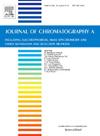In situ growth of hierarchical porous covalent organic framework coating for enhanced solid-phase microextraction of phenolic compounds
IF 3.8
2区 化学
Q1 BIOCHEMICAL RESEARCH METHODS
引用次数: 0
Abstract
Covalent organic frameworks (COFs), when utilized as solid-phase microextraction (SPME) coating materials, exhibit remarkable abilities to concentrate phenols by thousands-fold owing to their vast surface area and exceptional stability. However, the prevalent micropores inherent in COFs can impede rapid mass transfer of target molecules, prolonging SPME extraction times. To addresses this limitation, this work introduces a novel approach by integrating hierarchical porous structures into COFs, leveraging polystyrene microspheres as hard templates during the in situ growth process of the SPME coating. Due to the presence of a hierarchical porous structure derived from the template, the resulting hierarchical porous TpBD coating, termed HP-TpBD, demonstrated enhanced extraction efficiency, accelerated extraction kinetics, and notably shortened extraction times for phenolic compounds. Coupled with gas chromatography-mass spectrometry, a highly sensitive method featuring a low limit of detection (0.20–0.28 ng L-1), a broad linear range (1.0∼1.0 × 104 ng L-1), and excellent precision (RSD < 8.5 %) was established. This methodology enables accurate quantitative analysis of phenols in water and soil samples. This work provides valuable insights into developing COF-based SPME coatings for the efficient extraction of volatile contaminants, paving the way for more efficient and sensitive analytical procedures.
原位生长分层多孔共价有机框架涂层,用于增强酚类化合物的固相微萃取。
共价有机框架(COF)在用作固相微萃取(SPME)涂层材料时,由于其巨大的表面积和优异的稳定性,可将酚类物质浓缩数千倍。然而,COFs 中普遍存在的微孔会阻碍目标分子的快速传质,从而延长 SPME 的萃取时间。为了解决这一局限性,这项工作引入了一种新方法,即在 SPME 涂层的原位生长过程中,利用聚苯乙烯微球作为硬模板,将分层多孔结构集成到 COF 中。由于模板产生了分层多孔结构,由此产生的分层多孔 TpBD 涂层(称为 HP-TpBD)提高了萃取效率,加速了萃取动力学,并显著缩短了酚类化合物的萃取时间。该方法与气相色谱-质谱联用,灵敏度高,检出限低(0.20-0.28 ng L-1),线性范围宽(1.0∼1.0 × 104 ng L-1),精度高(RSD < 8.5 %)。该方法可对水和土壤样品中的酚类物质进行准确的定量分析。这项工作为开发基于 COF 的 SPME 涂层以高效萃取挥发性污染物提供了宝贵的见解,为更高效、更灵敏的分析程序铺平了道路。
本文章由计算机程序翻译,如有差异,请以英文原文为准。
求助全文
约1分钟内获得全文
求助全文
来源期刊

Journal of Chromatography A
化学-分析化学
CiteScore
7.90
自引率
14.60%
发文量
742
审稿时长
45 days
期刊介绍:
The Journal of Chromatography A provides a forum for the publication of original research and critical reviews on all aspects of fundamental and applied separation science. The scope of the journal includes chromatography and related techniques, electromigration techniques (e.g. electrophoresis, electrochromatography), hyphenated and other multi-dimensional techniques, sample preparation, and detection methods such as mass spectrometry. Contributions consist mainly of research papers dealing with the theory of separation methods, instrumental developments and analytical and preparative applications of general interest.
 求助内容:
求助内容: 应助结果提醒方式:
应助结果提醒方式:


